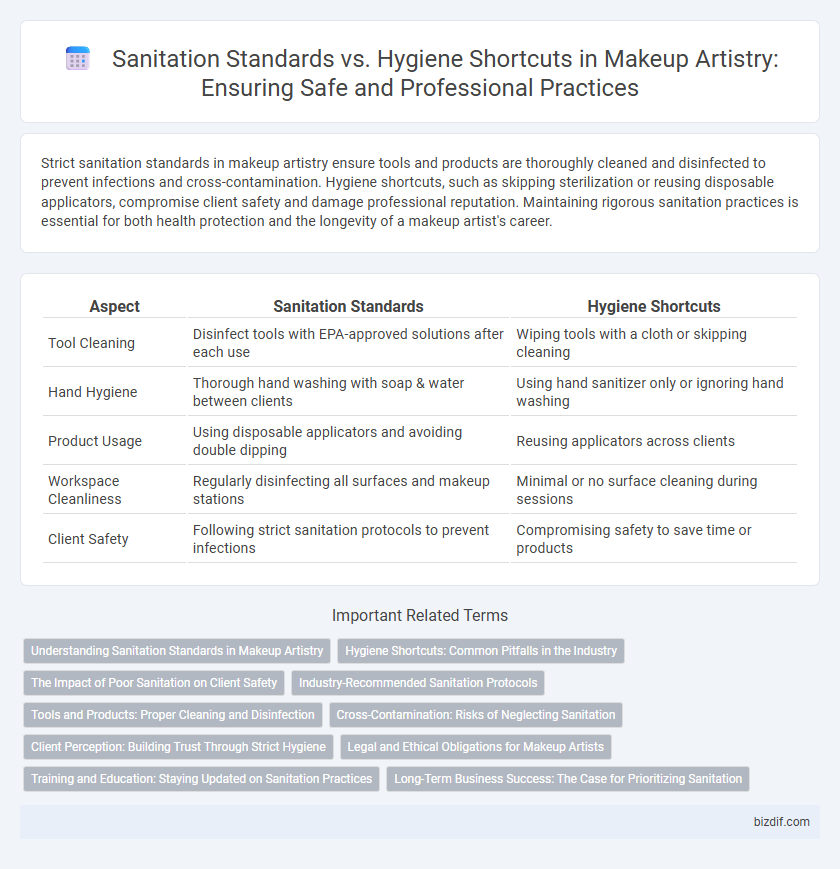Strict sanitation standards in makeup artistry ensure tools and products are thoroughly cleaned and disinfected to prevent infections and cross-contamination. Hygiene shortcuts, such as skipping sterilization or reusing disposable applicators, compromise client safety and damage professional reputation. Maintaining rigorous sanitation practices is essential for both health protection and the longevity of a makeup artist's career.
Table of Comparison
| Aspect | Sanitation Standards | Hygiene Shortcuts |
|---|---|---|
| Tool Cleaning | Disinfect tools with EPA-approved solutions after each use | Wiping tools with a cloth or skipping cleaning |
| Hand Hygiene | Thorough hand washing with soap & water between clients | Using hand sanitizer only or ignoring hand washing |
| Product Usage | Using disposable applicators and avoiding double dipping | Reusing applicators across clients |
| Workspace Cleanliness | Regularly disinfecting all surfaces and makeup stations | Minimal or no surface cleaning during sessions |
| Client Safety | Following strict sanitation protocols to prevent infections | Compromising safety to save time or products |
Understanding Sanitation Standards in Makeup Artistry
Sanitation standards in makeup artistry ensure the prevention of cross-contamination and the spread of bacteria, viruses, and fungi by enforcing strict protocols for cleaning and disinfecting tools and surfaces. Understanding the difference between proper sanitation and hygiene shortcuts is crucial, as shortcuts like wiping brushes on sleeves or using unclean sponges can lead to skin infections and allergic reactions. Adhering to professional sanitation guidelines, including the use of EPA-registered disinfectants and single-use applicators, maintains client safety and upholds industry credibility.
Hygiene Shortcuts: Common Pitfalls in the Industry
Hygiene shortcuts in makeup artistry often include skipping proper tool sterilization and reusing single-use products, significantly increasing the risk of infections and skin irritations. Neglecting thorough handwashing and surface cleaning creates a breeding ground for bacteria that compromise client safety. These common pitfalls undermine sanitation standards, emphasizing the critical need for strict hygiene protocols in professional makeup environments.
The Impact of Poor Sanitation on Client Safety
Poor sanitation in makeup artistry significantly increases the risk of infections such as bacterial conjunctivitis and skin irritations, compromising client safety. Contaminated tools and products can lead to the transmission of pathogens, causing allergic reactions and long-term skin damage. Upholding strict sanitation standards is essential to prevent cross-contamination and ensure a safe, professional environment for every client.
Industry-Recommended Sanitation Protocols
Industry-recommended sanitation protocols in makeup artistry emphasize sterilizing tools with hospital-grade disinfectants and replacing single-use applicators to prevent cross-contamination. Adhering to these standards reduces the risk of skin infections and ensures client safety, contrasting sharply with hygiene shortcuts that compromise cleanliness for convenience. Consistent use of gloves, clean work surfaces, and proper storage of products are essential elements in maintaining professional sanitation compliance.
Tools and Products: Proper Cleaning and Disinfection
Proper cleaning and disinfection of makeup tools and products are critical to preventing cross-contamination, skin infections, and allergic reactions. Adhering to strict sanitation standards ensures brushes, sponges, and applicators are thoroughly cleaned using appropriate solutions, while hygiene shortcuts like wiping tools with a tissue or quick surface sprays compromise safety. Consistent use of EPA-registered disinfectants and single-use applicators maintains professional hygiene, protects client health, and upholds the integrity of makeup artistry practices.
Cross-Contamination: Risks of Neglecting Sanitation
Neglecting sanitation in makeup artistry significantly increases the risk of cross-contamination, leading to infections like conjunctivitis and bacterial skin outbreaks. Proper sanitation standards, including sterilizing tools and using disposable applicators, prevent the transfer of pathogens between clients. Hygiene shortcuts such as reusing brushes or skipping hand washing amplify microbial spread, compromising both client safety and artist professionalism.
Client Perception: Building Trust Through Strict Hygiene
Strict sanitation standards in makeup artistry directly influence client perception by demonstrating professionalism and commitment to health safety, fostering trust and repeat business. Hygiene shortcuts, such as inadequate tool sterilization or skipping hand washing, can lead to cross-contamination, causing clients to lose confidence and potentially damaging the artist's reputation. Consistently following rigorous hygiene protocols not only prevents infections but also reinforces a positive image, making clients feel valued and secure during their beauty treatments.
Legal and Ethical Obligations for Makeup Artists
Makeup artists must adhere strictly to sanitation standards mandated by health authorities and professional organizations to prevent cross-contamination and skin infections. Legal obligations include using sterilized tools and disposable applicators while maintaining a clean workspace to avoid liability issues. Ethical responsibilities demand transparency with clients about hygiene practices, ensuring trust and safety within the beauty industry.
Training and Education: Staying Updated on Sanitation Practices
Consistent training and education in makeup artistry ensure professionals stay updated on evolving sanitation standards, effectively reducing contamination risks. Comprehensive programs emphasize proper tool sterilization, hand hygiene, and safe product handling to maintain client safety and professional credibility. Neglecting these practices for hygiene shortcuts compromises both health standards and artist reputation.
Long-Term Business Success: The Case for Prioritizing Sanitation
Maintaining rigorous sanitation standards in makeup artistry reduces the risk of infections and preserves client trust, fostering long-term business growth. Hygiene shortcuts often lead to compromised safety, resulting in negative reviews and potential legal issues that damage reputation. Prioritizing sanitation not only ensures compliance with health regulations but also differentiates professionals committed to quality and client well-being.
Sanitation standards vs Hygiene shortcuts Infographic

 bizdif.com
bizdif.com